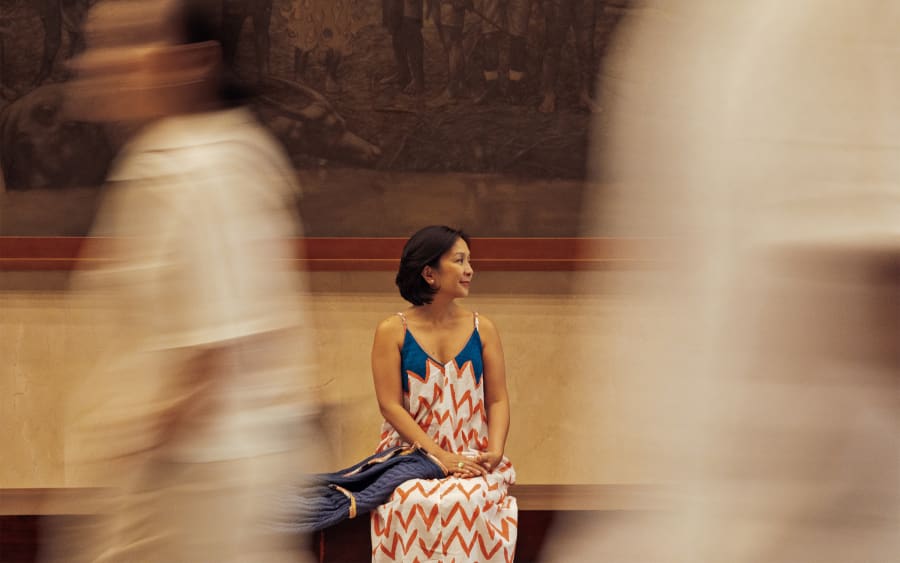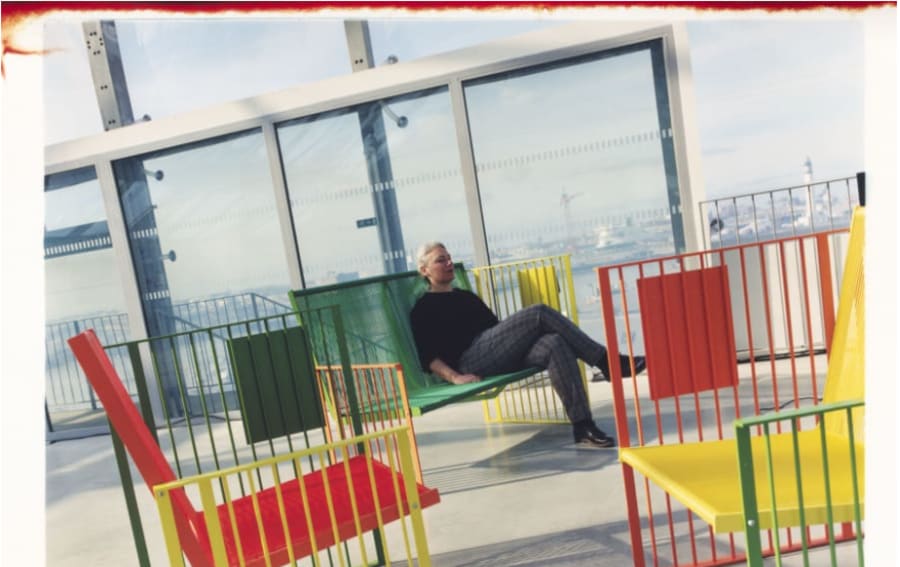A major new philanthropic public art project is set to transform Thailand’s art scene. Founded by patron Marisa Chearavanont – widely admired in Thai society for her down-to-earth manner and commitment to charitable initiatives – and led by former Hauser & Wirth director Stefano Rabolli Pansera, Khao Yai Art is an ambitious project that aims to make Thailand Southeast Asia’s premier hub for contemporary art.
When the first of Chearavanont’s two planned institutions, Kunsthalle Bangkok, launched this January, it instantly became the city’s most significant public contemporary art space. Its inaugural exhibition shone a spotlight on veteran French filmmaker Michel Auder and collated works ranging from the 1970s to new pieces made by the artist in Bangkok during a preceding residency. In a deft curatorial move, Pansera chose to open the show with Bangkok Yaowarat (2024), Auder’s brilliantly simple yet unexpectedly moving video of street life shot in the Kunsthalle’s immediate vicinity – a conceit that sympathetically blurred the boundaries between art and life.
Central to Khao Yai Art’s vision is a desire to encourage international artists to connect with Thailand, its communities and its cultures. New Yorker Emma McCormick Goodhart, Montreal-based Iranian artist Abbas Akhavan, and Italian Francesco Arena have all already been on residencies and worked on commissions. Forthcoming solo shows include American heavyweight Mark Bradford and local-hero-turned-global-icon Korakrit Arunanondchai.
Contrary to the starchitect approach often favored by new institutions, the Kunsthalle is reviving a vast brutalist building in Bangkok’s bustling Yaowarat (Chinatown) district. Once home to Thailand’s premier academic publisher, it was abandoned after its upper floors were gutted by fire 20 years ago. The Kunsthalle currently only occupies the ground floor, but there are plans to expand its exhibition spaces throughout the atmospherically distressed structure over the coming years.
Taking shape around 150 kilometres east of Bangkok, in the rural Khao Yai region, is Chearavanont’s second project, the Art Forest. Due to open to the public in November, this ecological and cultural initiative involves rewilding land previously denuded by mono-agriculture with native trees and flora. Set amid the forest will be sculptural works – including several Chearavanont acquired from the Panza Collection – by leading artists such as Roni Horn, Richard Long, and Richard Nonas with many further additions planned, as well as a series of newly commissioned pieces.
Art Basel caught up with Chearavanont and Pansera to discuss their plans and their journey so far.
Marisa Chearavanont: I first engaged with contemporary art when I was studying at New York University in the 1980s. I used to walk through Soho and see what was on at the galleries. It was a very different scene back then. Years later, at the end of the 1990s, I moved to Hong Kong with my husband and wanted to contribute to the art community. On our travels, I had encountered and collected beautiful work in places like Myanmar and Thailand. These artists were not being shown in Hong Kong back then, so I opened a gallery to showcase artists from across Southeast Asia. It was a commercial gallery, but we supported the artists as much as we could, so it was really a non-profit on our side!
The idea for Khao Yai Art project was conceived during the COVID-19 lockdowns, which is why healing and connection lie at its heart. The pandemic was a very difficult time for everyone, including me. In response, I started Chef Cares, a charity delivering food cooked for free by Bangkok’s top chefs to health workers in the city hospitals. I was taking part in the deliveries myself. Walking in a forest near my house was the only thing that kept me sane. I’m very much a city person and it was the first time in my life that I looked really closely at individual trees and wildflowers. It gave me such healing energy. By then, I had acquired part of the Panza Collection. I felt there was a serenity in the sensibility of those minimal and conceptual works that echoed the healing connection that I found in the forest. So I thought: Why not create a place where not only is the forest the hero but we also show art in a way that enables visitors truly to connect with the artworks?
I was lucky enough to have the opportunity to buy some land near a series of natural parks that form a transnational wildlife corridor which starts in Thailand and continues into Cambodia. It’s an incredible area of biodiversity and natural beauty. Our plot had been used for mono-agriculture for decades, though, so we are rewilding it with local trees and flora. I hope we can make that a collective experience and give every future visitor the chance to plant a tree so that, together, we can heal this land.
We’re also planning to build some modestly sized pavilions in which you will encounter only a few sculptures by one artist, so you can really connect with the artwork. They will be constructed by craftspeople from the local community, using materials from the area, like adobe brick and bamboo.
Stefano Rabolli Pansera: For me, both the Art Forest and the Bangkok Kunsthalle have evolved out of two key elements of Ms Chearavanont’s working method. Firstly, the idea of collecting being an act of collaboration with the artist, offering them a platform to conceive new ideas and produce new work. Secondly, and most importantly, that engagement with art – whether as an artist, patron, curator, or gallery-goer – can be a healing process through which we can come to terms with our own lives and situations.
In commissioning work for the Art Forest, we are inviting artists to visit the land, so they can be inspired by their surroundings, and encouraging them to use local materials. Franceso Arena, for instance, is interested in the relationship between text and sculpture. Using large stones found near the forest, he created Prachao (2024), a work about reading nature as an act of faith. Similarly, Fujiko Nakaya is creating what will be one of the largest permanent sculptures in her ‘Fog’ series (1970–ongoing) on the hills of Khao Yai.
Marisa Chearavanont: For me, the origin stories of the Kunsthalle and the Art Forest are similar in that they both began with places that were crying out for care and restoration. Some years ago, I was introduced to the brutalist building we now have for Bangkok Kunsthalle and it stuck in my mind because it was so beautiful but also so broken. I wasn’t able to view it until the pandemic restrictions were lifted, but, when I did, the uniqueness of the space blew my mind. I felt as if it was saying: “Please save me!” We’ve kept the space raw and humble – accessible. In fact, one of my friends arrived at the opening in a very glamorous black lace dress but was confused as to where the Kunsthalle was, assuming it would be a luxury venue. The kind owner of the noodle shop next door had to show her the way in!
Michel Auder loved this area when he came here to make new videos for the show. He made a 45-minute film documenting the loading of car parts into a truck right on the corner by the Kunsthalle. An endless succession of people – arriving in tuktuks, motorcycles, and cars – bring items to be loaded. Michel saw serenity and humor in all that frenetic activity. Lots of our neighbors are in the video, and I think it was an interesting moment of acknowledgement for them to realize that their lives could be the subject of an artwork. Many of these neighbors, and other members of the local community, come to the Kunsthalle regularly, sometimes spending several hours here.
Stefano Rabolli Pansera: That video is really a love letter to Yaowarat. It’s also a metaphor for Bangkok: to the outsider, it looks chaotic; in reality, everything is magically synchronized and connected. The response from all the artists who we have invited here has been enthusiastic and supportive. Emma McCormick Goodhart, a young artist from New York, was inspired by the signage you see all over Chinatown to create a public sculpture addressing the relationship between text and space. We’re going to have a permanent installation of her works on the rooftop of the Kunsthalle. Abbas Akhavan, who has just completed a residency with us, often draws from nature in his work and is developing a project with local plants that will be implemented both at the Kunsthalle and in the Art Forest.
The interactions and exchanges we have had so far have been wonderful and rich. It must also be said that, whilst much of our focus in starting these projects was to bring international artists to Thailand, we are equally intent on building a platform that will reciprocate and promote Thai art and culture internationally. We are currently in conversation with the Peruvian art platform proyectoamil, for instance, with the aim of fostering exchange programs that reinforce the South to South connection.
Nick Hackworth is the Director of Modern Forms.
Caption for top image: Exhibition view of Michel Auder, Five Plus Nine Works at Bangkok Kunsthalle, 2024. © Khao Yai Art.
Published on May 17, 2024.


